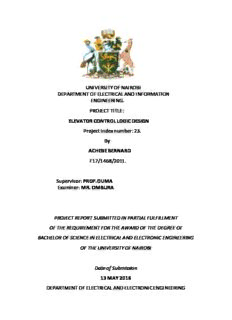Table Of ContentUNIVERSITY OF NAIROBI
DEPARTMENT OF ELECTRICAL AND INFORMATION
ENGINEERING.
PROJECT TITLE:
ELEVATOR CONTROL LOGIC DESIGN
Project Index number: 23.
By
ACHEBE BERNARD
F17/1468/2011.
Supervisor: PROF.OUMA
Examiner: MR. OMBURA
PROJECT REPORT SUBMITTED IN PARTIAL FULFILLMENT
OF THE REQUIREMENT FOR THE AWARD OF THE DEGREE OF
BACHELOR OF SCIENCE IN ELECTRICAL AND ELECTRONIC ENGINEERING
OF THE UNIVERSITY OF NAIROBI
Date of Submission
13 MAY 2016
DEPARTMENT OF ELECTRICAL AND ELECTRONIC ENGINEERING
DECLARATION OF CERTIFICATION
NAME OF STUDENT: Achebe Bernard.
REGISTRATION NUMBER: F17/1468/2011
COLLEGE: Architecture and Engineering
FACULTY/SCHOOL/INSTITUTE: Engineering
DEPARTMENT: Electrical and Electronic Engineering
COURSE NAME: Bachelor of Science in Electrical and Electronic Engineering
TITLE OF WORK: DESIGN AND IMPLEMENTATION OF A LOGIC CONTROL FOR A
4 LEVEL ELEVATOR USING A STEPPER MOTOR.
I understand what plagiarism is and I am aware of the University Policy
in this regard.
I declare that this final year project report is my original work and has
not been submitted elsewhere for examination, award of degree or
publication. Where other people’s work or my work has been used,
this has properly been acknowledged and referenced in accordance
with the University of Nairobi’s requirements.
I have not sought or used the services of any professional agencies to
produce this work.
I have not allowed, and shall not allow anyone to copy my work with
the intention of passing it off as his/her own work.
I understand that any false claim in respect of this work shall result in
disciplinary action, in accordance with the University anti-plagiarism
policy
This is my original work and has not been presented for a degree award
in this or any other university.
Signature………………………………Date……………………………….
ACHEBE BERNARD.
F17/1468/2011.
i
This report has been submitted to the Department of Electrical and Information
Engineering, University of Nairobi with my approval as supervisor:
………………………………………………..
Prof. Absaloms Heywood Ouma.
Date:
ii
DEDICATION
To God for his divine purpose in my life.
To my mum, for her continued support.
iii
ACKNOWLEDGEMENTS
We are created for a purpose and therefore I must be grateful to my
God for such a time, his divine power has always been the source of my energy.
I also appreciate my supervisor, Pro. Absaloms Heywood Ouma for his constant
dedication, support and guidance.
My appreciation too goes to my parents, lecturers, classmates, and non-
teaching staff at Electrical and Electronic department, University of Nairobi and
friends whose contribution cannot be underestimated.
Special thanks to My friend David Kariuki whose advice and motivation provided
a great jumpstart to see me continue even amidst challenges.
iv
Table of Contents
COVER PAGE
DECLARATION OF CERTIFICATION……………………………….………………………...…..………i
LIST OF FIGURES…………………………………………………………………………………………………ii
DEDICATION……………………………………………………………………………………………………...iii
ACKNOWLEDGEMENTS……………………………………………………………………………….……..IV
1. CHAPTER 1: INTRODUCTION…………………………………………………………….……..1
1.1 General Background……………………………………...……………………………….….………1
1.2 Main Objectives
1.2.1 Overall Objective…………………………………………………………………………..……………2
1.2.2 Specific Objectives…………………………………………………………………….…………..……2
1.3 Project Justification…………………………………………………………………………….………2
1.4 Project scope………………………………………………………………………………………………3
2. CHAPTER2: LITERATURE REVIEW…………….………………………………………....……..4
2.1 Introduction…………………………………………………………………………………………………....…….4
2.2 Elevators………………………………………………………………………………………………………...…….4
2.3 Stepper Motors………………………………………………………………………………….…………....……4
2.3.1 Application of Stepper Motor…………………………………………………………..…..……..5
2.3.2 Types of Stepper Motors…………………………………………………………..………….…….5
2.3.3 Stepper Motor Drive Circuits…………………………………………………………….…………8
2.3.3.1 Unipolar drive……………………………………………………………………………….….…..…….9
2.3.3.2 Resistance/Limited drive………………………………………………………………...………….9
2.3.3.3 Bipolar drive………………………………………………………………………………….………….10
2.3.4 Selection Criteria for stepper motor……………………………………..…………………..11
2.4 Stepper Motor Controllers…………………………………………………………………..……..………11
2.4.1 Microcontrollers and Microprocessors…………………………………………..………………..11
2.4.2 Programmable Logic Controller(PLC)…………………………………………….…………….….15
2.4.3 Relay Based Controllers……………………………………………………………….………….……..19
2.5 Electronic Display Devices………………………………………………………………..……….………20
2.5.1. Types of electronic displays………………………………………………………………20
2.5.2. Seven segment display……………………………………………………………………..21
2.5.3. LCD(Liquid Crystal Display)………………………………………………………….……24
2.6 Power Supply……………………………………………………………………………….…………………..26
2.6.1. Transformer………………………………………………………………………………………………….27
2.6.2. Voltage regulators………………………………………………………………………………….……27
2.6.3. Diode bridge………………………………………………………………………………………….…....27
2.6.4. Filter circuit……………………………………………………………………………………………….…28
2.7 Switches………………………………………………………………………………………….…….………..29
2.8 Conclusion……………………………………………………………………………………………………….31
3. CHAPTER 3:DESIGN…………………………………………………………………….……..32
3.1 Introduction………………………………………………………………………….….…..32
3.2 System definition…………………………………………………………….…….……..32
3.2.1.Inputs………………………………………………………………………………….….……33
V
3.2.2.Motor……………………………………………………………………………….…………35
3.2.3.Cab……………………………………………………………………………………….………35
3.2.4.Controller…………………………………………………………………………….…….…35
4. CHAPTER 4: IMPLEMENTATION……………………………………………..….….….…38
4.1 Components used…………………………………………………………………....……40
4.1.1 Connection of 28BYJ48…………………………………………………….…….….40
4.1.2 Power supply circuit……………………………………………………….………...41
4.1.3 Arduino mega 2560…………………………………………………………….……..42
4.1.4 7 segment display………………………………………………………………..…….43
4.1.5 Pushbuttons……………………………………………………………………………….45
4.1.6 Project overview…………………………………………………………………….…..46
4.2 The general hardware circuit diagram…………………………………….…….48
4.3 The software implementation………………………………………………….……..51
5. CHAPTER 5:RESULTS AND EVALUATION……………………………………………..52
5.1 Introduction……………………………………………..……………………..52
5.2 Achievements…………………………………………………………………………….…52
5.3 Challenges……………………………………………………………………………….…..53
5.4 Recommendations……………………………………………………………………….53
5.5 Conclusion………………………………………………………………………….………..54
5.6 Appendix………………………………………………………………………….………….54
5.6.1 The code used………………………………………………………………….….……..54
5.6.2 Time budget………………………………………………………………………...……65
5.6.3 References………………………………………………………………….………………66
V
TABLE OF FIGURES
FIGURE DESCRIPTION PAGE
2.1 Unipolar stepper motor 7
2.2 Bipolar stepper 8
2.3 Unipolar stepper driver 9
2.4 Bipolar stepper driver 10
2.5 Microprocessor system 13
2.6 Basic PLC structure 16
2.7 Relay based controller 19
2.8 Seven segment display 21
2.9 Power supply circuit 28
3.1 System design flow chart 33
3.2 Outer door button design 34
3.3 Controller flow chart 38
3.4 Door opening and closing logic 39
3.5 Power supply circuit 41
3.6 Arduino mega 2560 42
3.7 Project structure 47
3.8 Hardware circuit diagram 48
3.9 Complete model 49
3.10 Control circuit 50
V
1.2 Main Objectives
1.2.1. Overall Objective
The main objective of this project is to design and implement logic for a 4 level elevator using a
stepper motor and demonstrate on a model
1.2.2 Specific Objectives
In accomplishment of the main objective, the following areas need to be properly understood.
i. To study and understand the types, the operation principles and applications of
elevators, stepper motors and the controllers.
ii. Application of above concepts in design and implementation a control logic for
elevator model.
iii. Integration, building and testing of a 4 level elevator control logic.
1.3 Project Justification
Technological shift in building and construction has led to development of high structures like
skyscrapers which have made it necessary for an even more efficient access system. As a
results of this there is a need to develop a cost effective and efficient logic control system that
assures safety and simplicity to the users without compromising on the quality. This has
therefore prompted for a more research and development of better control systems for
elevators.
2
Description:ELEVATOR CONTROL LOGIC DESIGN. Project Index number: 23. By. ACHEBE BERNARD. F17/1468/2011. Supervisor: PROF.OUMA. Examiner: MR

